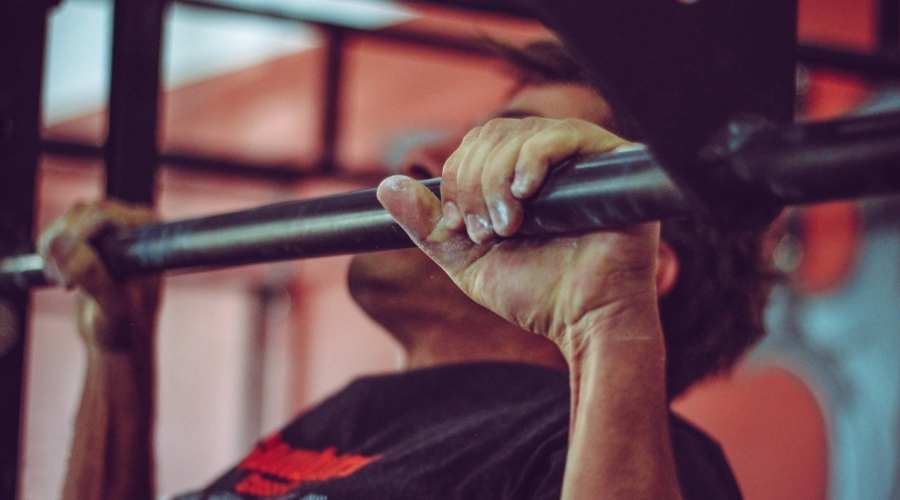Cindy stands out as a benchmark CrossFit WOD. You record your results each time you do it, so you can measure your progress.
It is also an AMRAP (As Many Rounds As Possible) because you complete as many of the following movements sequentially as you can in 20 minutes.
- 5 pull-ups
- 10 push-ups
- 15 squats
The workout looks easy on paper, but having done it a few times, I can assure you that it’s one of the most strenuous workouts in the CrossFit list.
Pluses
Cindy appeared on the CrossFit website in 2005 as one of “The Girls,” a set of benchmark WODs designed to check and improve strength, power, speed, and flexibility.
- Beyond a pull-up bar, Cindy does not require any equipment and can be done in a relatively small space.
- The movements are ones that everyone is familiar with from PE class at school.
- Each movement is simple enough for anyone to do.
And yet, when done continuously, the WOD burns about 260 calories in the short timespan, as discovered by the American College of Sports Medicine in a 2014 study.
Athletic Levels
Cindy is strenuous enough that the CrossFit website recommends that it be performed as is by intermediate athletes or better.
- Beginners or “deconditoned athletes should reduce the duration and modify movements to workout through each round at a consistent pace.” I’ll talk about scaling modifications later, but you want to adjust the movements so you can do each set continuously.
- If you require more challenge, try wearing a weighted vest.
Canyou do the Cindy WOD every day?
If Cindy is such a good workout, should you do it every day? It depends on your fitness level and motivation, but the short answer is “no.”
Here’s why:
- The entire point of CrossFit is to perform different exercises with every WOD to challenge different fitness components and work out different parts of your body. Doing Cindy every day runs counter to that.
- In order for your muscles to grow, they require rest. Doing the same WOD every day stresses the same body parts without giving them time to rest.
- Even CrossFit Pros do not train every day. According to CoachsLife, these elite-level athletes train in one weeks only for five days, have one recovery day, and take one day off.
A Breakdown of the Cindy WOD exercises:
The Strict Pull-Up
For a strict pull-up, you need a bar that is high enough to let you hang from it without your feet touching the ground. Your hands should reach just outside shoulder width as you fully grip the bar.
Keep your chest up and eyes forward as you pull yourself up until your chin is higher than the bar. Then lower yourself slowly until your arms are fully extended.
Or Try a Kipping Pull-up
The kipping pull-up is supposed to be an easier version for those who can’t do a strict pull-up. (I’ve never been able to master its complexities.) You assume the same position as a strict pull-up.
- Swing your shoulders forward until your body assumes an arched position and then swing backward until your body assumes a hollow position.
- You then lift your feet toward the bar while pressing down with straight arms. As your body goes up, extend the hips and then pull with the arms until your chin is above the bar.
- Push away from the bar to go down and start over.
Scaling the Pull-Up
If you can’t do a strict or kipping pull-up, try these variations:
- A banded pull-up stretches a resistance band over the bar or below your foot between two J-hooks on the rack. You put your foot on the band, which helps push your body up. Bands are available at different strengths, or you can use two bands if you need more help.
- With an L-sit, you hang from the bar and raise your legs in a straight line until they are parallel to the ground. Then drop the legs.
- A hanging knee raise lifts your knees as high as they can go before dropping them.
Push-Up
When done correctly, a strict push-up requires both upper body strength and core strength.
- Lay face-down on the ground with your hands shoulder-width apart near your chest with palms to the ground. Keep your legs together with just the balls of your feet touching the ground.
- Start with your arms extended to lift your chest as high as it will go.
- Keeping your body rigid and your elbows close to the body, lower your chest and thighs to the ground.
- Push down with your hands and extend your arms to lift your chest once more.
Try different hand widths until you find one that lets you maintain a consistent push-up pace.
Scaling
If a standard push-up is too difficult, try doing it on your knees. You can also start with your hands on a box, so your body is at an incline.
A wall push-up is the easiest variation. Stand up and put your hands on a wall with your body bending forward on a diagonal. Push your body away from the wall and then move it toward the wall. The farther your feet are from the wall, the more difficult the movement becomes.
Air Squat
The air squat is a natural movement that uses your thighs, quadriceps, hamstrings, and glutes. You must also engage your core to maintain balance. Because it stresses the biggest muscles of your body, this movement can prove to be the most strenuous.
- Stand with your feet shoulder-width apart. Your feet should be slightly spread out.
- Drop slowly into a sitting position, leading with your glutes rather than your knees. Keep your knees in line with the toes and keep your chest up to maintain the curve of your back. You can extend your arms to help keep your balance.
- After your hips descend to their lowest point below the knees, lift them up until you are in a standing position again. Be sure to keep your heels flat to the ground throughout the entire movement.
For a greater challenge, do a single-leg pistol squat. Drop down only on one leg and lift your other leg as high as you can go. Go down only until your thigh is parallel to the floor before standing up. Alternate legs with each rep.
Scaling
The easiest way to scale the air squat is to go down only as far as your body will take you before standing up again.
If you have problems with your hips or knees, lean back against a wall for support and as you go into the squat, pin your back into the wall. Drop only until your knees are parallel to the floor before standing up again.
Cindy Scores To Shoot For
The number of rounds that you can complete in 20 minutes for Cindy vary by fitness level. Here are some scores to shoot for:
- Beginner: 11-12
- Intermediate: 13-17
- Advanced: 19-22
- Elite: 24 and above
At the 2009 CrossFit Games, Chris Spealler did 38 rounds of Cindy for the men, while Gillian Mounsey and Charity Vale tied with 28 rounds each for the women.
Going For Mary
If Cindy becomes too conventional for you, you can try a more challenging benchmark WOD called “Mary.” It consists of the following movements:
- 5 handstand push-ups
- 10 one-legged pistol squats
- 15 pull-ups
Handstand Push-Up
All the movements of this exercise were previously described except for the handstand push-up, which impresses as a challenging elite-level exercise.
- Perform a handstand facing a wall. With your hands just outside shoulder-width, press against the wall and extend your arms.
- While bracing your abs, move your elbows forward to bring your body and head towards the floor.
- When your head touches the ground, push with your arms to raise your body and head until your arms are fully extended.
If you find dropping down on your head too jarring, put a small pad or cushion underneath it.


